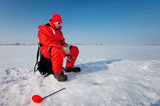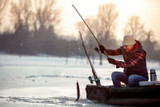Best Time To Go Fishing
Finding the perfect time to go fishing can increase your chances of a successful catch. Whether you’re a seasoned angler or a beginner, understanding how weather, water temperature, and fish behavior influence your fishing results can make the difference between a bountiful catch and a frustrating day on the water.
Discover the best time to go fishing, how to choose the right tools, and plan your trips around peak fishing conditions.
Understanding Fish Behavior
To master the art of fishing, you need to understand the behavior of the fish species you are targeting. Fish are cold-blooded creatures, and their metabolic rates, activity levels, and feeding habits are affected by surrounding environmental factors such as water temperature, light levels, and atmospheric pressure.
For example, some fish species, such as catfish and loaches, are more active during low-light conditions, while others, like marlin and red mullet, thrive in warmer waters.
Also, during the spawning season, many fish species may become more aggressive and territorial, making them more likely to strike the bait.
So, before you set out on your next fishing trip, do some research on the specific fish species you’re targeting to help ensure your ice chest is full.
The Role of Weather Conditions
While timing is critical, paying close attention to weather conditions is equally crucial for a successful fishing trip. Various weather factors can influence fish behavior and activity levels, including:
- Temperature. Fish are ectotherms, and water temperatures drive their metabolism and feeding habits. They tend to be more active when temperatures are within their ideal range.
- Barometric pressure. Falling pressure often triggers increased feeding as fish sense an approaching storm or weather change. Meanwhile, rising pressure can make them lethargic.
- Cloud cover. Overcast conditions can spur activity as clouds mimic low-light periods fish associate with dawn and dusk feeding times.
- Precipitation. Light rain can be ideal, washing insects and food sources into the water, while heavy downpours can make fish sluggish.
- Wind. Wind influences fish behavior by mixing water layers, affecting temperature and oxygen levels, and redistributing food sources. It also creates waves that stir up nutrients, attracting fish, but too much water turbulence can drive them to deeper waters.
Time of Day Matters
The time of day can affect fish behavior and feeding patterns. Although you can go fishing at any time of day, certain periods are generally more productive than others.
- Dawn and dusk. The hours around sunrise and sunset, often called the “magic hours,” are prime fishing times. During these periods, the changing light conditions and cooler temperatures trigger increased activity in many fish species as they move into shallower waters to feed.
Low-light conditions also make fish feel more secure and less wary of potential predators, increasing their willingness to strike.
- Midday fishing. Midday fishing can be challenging, especially during the summer when the sun is at its peak. The intense heat and bright light can drive fish into deeper, cooler waters, making them less active and less inclined to bite.
However, if water temperatures are still within the ideal range for your fish species and there is ample shade or cover, midday fishing can still be productive for certain fish.
- Night fishing. Night fishing offers a unique experience and can be particularly rewarding for species that are more active during low-light conditions. Many predatory fish, such as bass, catfish, and walleye, become more active at night, making it an excellent time to target them.
Night fishing also requires specialized equipment like high-visibility lines, rigging flashers, and lighted bobbers, as well as specific techniques and additional safety precautions.

Moon Phases and Tides
Moon phases can also influence fish behavior, particularly in saltwater environments. During the new moon phase, when there is minimal moonlight, many fish species become more active and tend to feed more aggressively. However, the full moon phase can sometimes make fish slower and less inclined to bite.
Although this fish behavior can also be seen in freshwater environments, the impact is typically less pronounced than in saltwater. Some anglers believe that certain moon phases, such as the new or full moon, can influence the feeding patterns of certain freshwater species.
For saltwater fishing, timing your trips around the tides is critical. Tides can impact the movement and feeding patterns of coastal fish species. Generally, the hours around high and low tides are considered prime fishing times, as the water movement stirs up baitfish and encourages feeding activity.
Seasonal Considerations
Every season offers different opportunities and challenges for fishing. Knowing how fish behavior shifts with the seasons can help you adapt your fishing tactics.
- Spring. Spring is often considered one of the best times for fishing, as many species become more active after the winter dormancy. During this season, fish feed aggressively to replenish their energy reserves after the long winter months.
- Summer. While fish are generally more active due to warmer water temperatures, the intense heat and midday sun can drive them into deeper, cooler areas, making them less accessible.
- Fall. Fall is another prime fishing season, as many species engage in a feeding frenzy to prepare for the upcoming winter. Cooler temperatures and changing foliage can increase fish activity, making them more inclined to bite. The reduced vegetation in the water also makes it easier to locate and catch them.
- Winter. Winter fishing has its challenges, but you can still catch species like walleye and trout, especially when ice fishing. Fishing in deeper waters and using techniques like slow bait presentation and jigging can help you have a successful outing during the colder months.
Local Knowledge is Key
Local knowledge and experience can be invaluable when determining the best time to go fishing in a specific area. Consulting with local anglers, bait shop owners, and fishing communities can provide insights into the behavior of local fish populations and the most productive times and locations.
Participating in local fishing events and forums can also help you stay up-to-date with the latest fishing reports, techniques, and trends specific to your region. Local anglers often have a wealth of knowledge about the habits of fish in their area, and their insights can help you time your trips more effectively.
Tools and Technology to Help You Decide
In our modern digital world, anglers can take advantage of various tools and technologies designed to help determine the optimal time to go fishing, including:
- Fishing apps and websites. Several apps and websites offer predictions for the best fishing times based on weather, moon phases, tides, and solunar tables.
These resources can provide in-depth insights to help you plan your fishing trips for the best time possible. Some popular apps include FishAngler, Fishbrain, and Farmers’ Almanac.
- Solunar tables. Solunar tables are charts that show the daily fluctuations in the moon’s overhead position and its influence on fish activity.
Some anglers believe that fish are more active during periods of peak solunar activity, making these tables a useful tool for timing fishing trips. You can find solunar tables in many fishing publications or online.
- GPS and fish finders. GPS and fish finder technology can also be excellent resources for locating productive fishing spots and understanding the underwater terrain.

At FISH307, we offer a range of high-quality fish finders, such as the Garmin Striker, Lowrance Eagle 5, and Humminbird Helix10, with add-on technologies like i-Pilot Link, designed to help you locate fish, structure, and underwater features with precision.
- Weather forecasting apps. Apps like AccuWeather and WeatherBug can provide detailed weather forecasts, including information on wind, precipitation, and barometric pressure changes. You can plan your fishing trips around favorable weather patterns by monitoring these conditions.
Experimentation and Experience
While tools and technology are helpful on the water, nothing beats personal experience and experimentation. Maintaining a fishing log to track your successful and unsuccessful outings noting the conditions and variables involved, will improve your understanding of when to fish in your local area.
Remember that every fishing trip is a chance to learn and improve. Don’t let unsuccessful trips get you down; instead, see them as opportunities to tweak your approach and improve your timing for future excursions.
Make the Most of Your Time on the Water with FISH307
Timing is vital for successful fishing, but there are other important factors such as equipment that can help you land a big catch. At FISH307, we stock everything from high-quality rods and reels to the latest fish finders and accessories, ensuring you’re well-equipped for any fishing adventure.
Reach out to us today to speak with our knowledgeable staff about our range of fishing gear. The best time to go fishing is when you have the right knowledge, tools, and equipment. Let FISH307 be your go-to guide for mastering the art of fishing and ensuring every trip is a success.
Recent Posts
-
Ice Fishing Safety 101: What Every Angler Needs To Know
Ice fishing offers a unique thrill, but safety should always come first. Knowing the basics of ic
-
Ice Fishing Season Prep: Your Essential Pre-Ice Checklist
When the lakes start freezing, it’s time to swap your boat for an ice auger. But before you hit the





